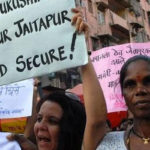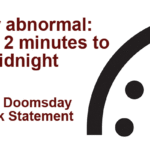By Kumar Sundaram|December 31, 2018
https://www.wagingpeace.org/indias-immodest-nuclear-quest/#.XC-xV-XXXnM.twitter
The passing year marked the 20th year of the May 1998 nuclear tests in Pokhran, the 10th year of the unprecedented exception from the Nuclear Suppliers’ Group (NSG) that the Indian government achieved in 2008, and the last effective year of the ultra-nationalist Modi government as it enters its lame-duck phase early next year. An overall look at the nuclear-related developments in India in 2018 reveals no remarkable development this year – neither have any exceptional acquisitions or advancements been made by the government, nor has any massive anti-nuclear people’s mobilization taken place at the grassroots compared to the immediate post-Fukushima years. On all these counts, the observable surface-reality appears less remarkable than what most observers would have expected.
The 20th anniversary of the nuclear tests remained rather low-key, at least in comparison to the chest-thumping frenzy and hyperbole that the Modi government has come to be known for. The release of a commemorative Bollywood movie, insipidly titled Parmanu(atom), was announced to coincide with the occasion, but it was silently and inexplicably postponed by a few weeks and the film remained a non-starter despite its over-dramatic nationalist treatment of the subject. While in his pre-election rallies prior to 2014, Narendra Modi had promised a radical alteration of India’s nuclear posture and the shunning of the country’s long-standing policies of ‘no-first-use’ and ‘minimum credible deterrence’ with regard to nuclear weapons, his government did not go beyond heightened nuclear rhetoric against Pakistan.
On the nuclear energy front, progress has been tediously slow and prospects for even the revised short and medium-term projections look grim although the government remains committed to pursuing both, imported and locally-designed nuclear plants. This year, the government announced an ambiguous nuclear plan for the year 2030 and beyond, which was widely perceived as a scaling down of its nuclear ambitions. Despite the NSG opening the doors of international nuclear supplies for India in 2008, and in effect, rewarding the country for its 1998 nuclear tests, not a single foreign-imported reactor construction, sanctioned since 2008, has started in India.
However, it is precisely this deceptive calm and seeming indolence on the part of the Indian government that makes it easy to miss out the details and the deeply worrying patterns of an unmistakable push for a massive nuclear weaponization and energy expansion that we should all be concerned about.
Even as the international gaze is set firmly on the increased nuclear instability owing to the misadventures of the American President vis-à-vis Russia, North Korea, and Iran on the one hand, and desperate attempts by the global nuclear industry to stage a comeback from perhaps its deepest crisis so far, by painting itself as an ‘urgent’ and ‘imperative’ solution to climate change, India is engaged in a steady albeit understated consolidation of its capacities and postures in terms of both, its civilian and military nuclear programs.
The Unquestioned ‘Normalization’ of a Nuclear State?
The uncharacteristic and confounding absence of hyped official celebrations of the 20th anniversary of India’s nuclear weapons tests were met with an equal silence on the part of the political opposition and civil society. Surprisingly, the 2018 Pokhran anniversary did not occasion any protests by either the major left-wing parties or civil society groups. This however, can also be explained by the fact that the political opposition, activists and civil society in India have found themselves unremittingly firefighting other, more immediate issues that have hogged the limelight during the BJP government’s tenure – its gross mishandling of the economy and public offices as well as the havoc unleashed by Hindutva groups on the streets almost every other week on ever newer issues ever since Modi’s ascendance.
However, this is definitely a reflection on the fact that nuclear weapons have fallen off the radar of public concern in India. In effect, this has meant an almost unquestioned and matter-of-fact acceptance of nuclear weapons and the relentless pursuit of a maximization of India’s nuclear capacities.
India has consistently expanded its missile program, both qualitatively and quantitatively and has tested as many as eight nuclear-capable delivery vehicles this year itself. Besides, India launched an ‘Advanced Area Defense (AAD) missile this year, capable of intercepting incoming missiles, which the government has claimed as part of the country’s home-grown missile defense system. India also operationalized the nuclear-armed submarine Arihant’s patrolling in the Indian Ocean. Observers have raised concerns about the Indian nuclear triad – land, sea and air-based nuclear capabilities further provoking Pakistan, which is already engaged in miniaturizing its nuclear arsenal to make it more ‘usable’, thus, fueling an arms race in South Asia. India also figured as among the key reasons for the Bulletin of Atomic Scientists moving its famed ‘Doomsday Clock’ closest-ever to midnight since its inception. However, the international response has been far more muted than the outcry on Iran and South Korea. This has also allowed India to maintain its low-key posturing as well as the government’s strategy to perpetuate the image of “good nukes” and a “responsible nuclear state”, which the US and other big powers have willingly and actively permitted India to adopt and proclaim. The Nobel prize-winning International Campaign to Abolish Nuclear Weapons (ICAN) has highlighted the very real dangers of such nuclear hypocrisy. Resultantly, the nuclear escalation in South Asia continues unabated and perhaps enjoys far more political consensus than in 1998 when nuclear weapons were tested by India and Pakistan. Questioning the nuclear arms and military build-up has also become rather perilous, since in recent years, civil society activists and dissenters of all shades have been unrestrainedly labeled ‘anti-national’ by the ruling BJP government on the flimsiest pretexts.
Besides the military nuclear sector, the nuclear power industry is also being steadily expanded by India even as it lags behind in terms of the ambitious announcements made earlier. Even as the global nuclear industry faces bankruptcies and terminal economic crises, the Indian authorities have used the opportunity in the most perverse manner. Rather than occasioning a serious rethink about the viability and risks of nuclear power, the situation has led the Indian government to ask the imperiled nuclear corporations in the West for technology transfers with the outrageous claim that these nuclear projects can be constructed by engaging private domestic companies, with absolutely no experience in nuclear construction. The French nuclear industry, now snowed under a steep decline, has been more than willing to oblige, and, Prime Minister Modi has announced ‘maximum localisation’ of the EPR design that has been questioned across the world and has been a crucial reason for the meltdown of Areva in France. This year, America’s GE also entered the Jaitapur project and signed strategic cooperation agreements with EDF and Nuclear Power Corporation of India Ltd (NPCIL). This patch-work approach to salvage the world’s largest nuclear project and promote Modi’s ‘Make in India’ pitch has understandably raised serious concerns. Even as the future of the Jaitapur project on India’s western coast remains uncertain, the Indian government in December this year announced the completion of its land acquisition which has meant the forced eviction of villagers on ground and suppression of the local communities’ agitation by stick-and-carrot tactics. Despite losing their lands, the villagers continue to protest the loss of livelihoods and safety risks that the nuclear project has and will bring to them. This year in August, hundreds of people in the Jaitapur region courted voluntary arrest – ‘jail bharo’ as a form of protest.
Both the Kovvada and MithiVirdi project sites, allotted to the US corporations GE and Westinghouse since 2008 continue to figure in the government’s projections despite running into serious trouble. The ruling party’s own Chief Minister in the State of Gujarat has assured the people that the MithiVirdi project will never be started as the safety concerns and farmers’ protests are ‘legitimate’, and after GE’s exit from Kovvada, citing liability in 2015, the government has allotted the site to Westinghouse and the uncertainties of the ongoing negotiations have not stopped the Indian government from pushing ahead with land acquisition.
While the future of the US and French nuclear projects in India remains uncertain, Russia has come to India’s rescue. This year, the government signed design contracts with Russia for Units 5 and 6 of VVER reactors in Koodankulam and launched the construction of Units 3 and 4 despite glaring failures of Units 1 and 2. India has also signed a new nuclear deal with Russia for six more reactors at a new site that remains officially unannounced.
Given the complications of starting Western-imported nuclear projects, the Indian government seems to have shifted its focus to the domestically-built ‘indigenous’ Pressurized Heavy Water Reactors (PHWRs). Last year, the government repackaged the plans for 10 such reactors with 700 MW capacity each. This year, excavation work has started in Gorakhpur and the government has continued land acquisition and environmental clearance efforts for Mahi-Banswara and pre-project activities in Chutka. The localised nuclear expansion has also included construction of more PHWRs in existing plants like Kaiga where the government recently conducted a farcical public hearing on the Environmental Impact Assessment report, which has been criticized by independent experts. Despite the generally slow growth of the nuclear sector, India has steadily increased its import of uranium fuel from Canada, Kazakhstan and other countries.
India’s nuclear arsenal and missile capabilities continue to grow quietly, under an otherwise grandiloquent and ultra-nationalist regime. And even though the nuclear power sector’s growth appears to be painfully slow, the Indian government has firmly set the country on a course of a full-spectrum technology-ownership in the nuclear sector, and, is using every available opportunity, including the decline of international nuclear industry, towards this grandiose ambition.
One might ask then, if it is by design that the Indian government ignores the attendant problems of an unrelenting pursuit of nuclear projects like the EPR, even as the horror of Fukushima continues to unfold before us, and whether, the growth of its nuclear sector, no matter how snail-paced, ensures a ‘legitimate’ and comprehensive growth of nuclear technology, which in turn provides India not just military wherewithal, but also diplomatic stature and the leverage to enhance its long-term power projection, as well as withstand any sanctions in the future in the event that the country conducts nuclear tests? As nuclear power in the present situation does not make sense on either financial or safety grounds, it is only this super-power ambition which is plausibly guiding India’s overall nuclear strategy. India’s chequered nuclear past is reason enough to believe so.


